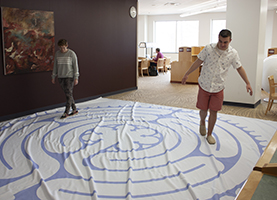The last two weeks of the spring semester are especially busy for students. The whirlwind of exams, papers and projects, packing up for the summer, and for some students, graduating, may lead to increased levels of stress and anxiety.
The library offers a refuge from the fast pace of academic life and a quiet oasis in a noisy world. Last December, we introduced labyrinth walking as one of the De-stress Zone activities on the Park Library’s second floor. However, we are neophytes when it comes to labyrinth walking.
Fortunately, Michelle Bigard, Associate Director of CMU’s Counseling Center, is an expert. She has written numerous articles about labyrinth walking and leads workshops to introduce students, faculty, and staff to its practice. Michelle promotes labyrinth walking as a form of self-care that relaxes your body and quiets your mind. I recently interviewed Michelle to learn more.
KI: Describe your first experience with labyrinths.
MB: I was working at a psychiatric hospital at the time and participated in a weekend retreat led by our chaplain. During the retreat, we made a labyrinth from scratch and walked it in several different ways. Afterward, we processed our experiences using art. Walking the labyrinth felt like a very safe time out. We were encouraged to let the labyrinth walking experience be what it needed to be. Although multiple people were walking the labyrinth, I experienced a solitary feeling, being alone in public. I also felt the support of those around me.
KI: What does a labyrinth symbolize?
MB: A labyrinth represents the paths of life, a journey, or different places in your journey. Walking a labyrinth mirrors back to you where you are right now on your journey in life.
KI: What are the advantages of walking a labyrinth?
MB: It helps you get out of your head. It helps you notice your thoughts and emotions without judgment. Walking is a tactile experience. Your breathing slows down to match your pace. You must look down at the path, otherwise, you will veer off the path. Looking down brings your focus inward and to the present moment. Afterward, any tension you were feeling will have dissipated and you will feel more rested. When we feel rested, we are better able to be relational.
KI: How might walking a labyrinth help students practice good self-care?
MB: Labyrinth walking helps you pause and reflect. It helps you pay attention to what’s going on with a sense of curiosity and enables you to be responsive rather than reactive. It stops the noise in your head and allows you to take your time making choices.
KI: Describe the process of walking a labyrinth.
MB: Sometimes, the less a person knows, the better. Allow yourself to take a break. As you begin walking, settle into a comfortable pace, not too fast, not too slow. Notice what comes up. Be curious. Ask, “What am I learning about myself? What do I want to do with what I learned?” As you exit the labyrinth, ask, “What am I coming back to? How can I be of service?” Some people release expectations and feel a greater sense of purpose.
KI: Do you have to set an intention before you begin walking?
MB: No, just do it. See what shows up.
KI: What would you say to someone who is not sure they want to walk the labyrinth?
MB: Observe others walking it. Walk around the perimeter. Try a finger labyrinth – they’re like fidget toys.
KI: Any last words of wisdom?
MB: I recommend keeping a journal to process your experiences walking the labyrinth. Doesn’t have to be words, could be a drawing. When you process the experience, you can hold on to what you learned.

The library’s labyrinth is located north of the book checkout desk and will be available from April 21st through May 2nd.
Want to learn more about labyrinth walking? Check out these articles and resources:
Articles
Bigard, M. F. (2005). Walking the labyrinth: Enhancing spiritually sensitive clinical practice. Reflections: Narratives of Professional Helping, 11(3), 84-95. Retrieved from https://reflectionsnarrativesofprofessionalhelping.org/index.php/Reflections/article/view/1158/972
Bigard, M. F. (2009). Walking the labyrinth: An innovative approach to counseling center outreach. Journal of College Counseling, 12(2), 137-148.
Billock, J. (2016, January 20). Walk the world’s most meditative labyrinths. Retrieved from https://www.smithsonianmag.com/travel/walk-worlds-meditative-labyrinths-180957823/
Quenqua, D. (2015, April 30). The labyrinth revival. Retrieved from https://www.theatlantic.com/health/archive/2015/04/the-labyrinth-revival/391517/
Online resources
The Labyrinth Company sells canvas labyrinths like the one at the Park Library. They also sell stencils and kits to build a labyrinth out of various materials indoors or outside.
The Labyrinth Locator is co-managed by the Labyrinth Society and Veriditas.
The Labyrinth Society is a non-profit organization based in St. Louis, Missouri, that supports those who create and use labyrinths through training and networking.
Veriditas is a non-profit organization based in Petaluma, California, that provides training and resources for labyrinth facilitators.

